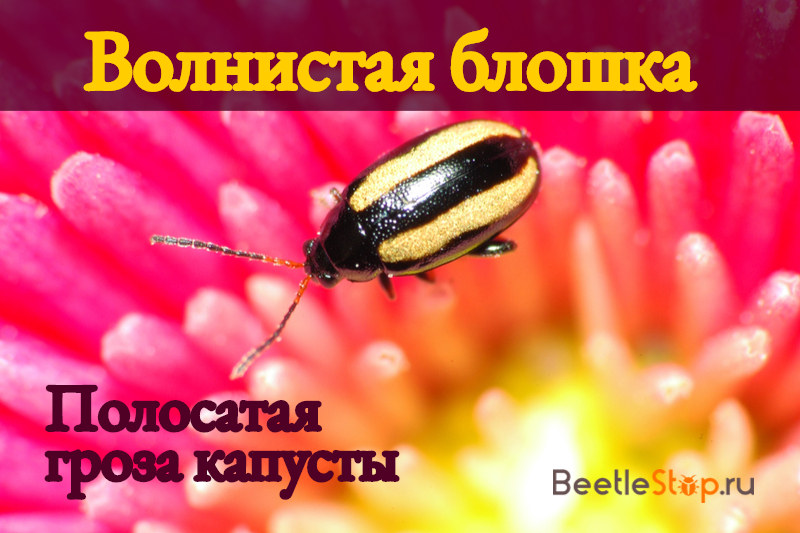Wavy flea - striped pest on cabbage and radish
The leaf beetle family is one of the largest groups of beetles. Its representatives eat on the leaves, often causing a lag in the growth or death of plants. The wavy flea is a dangerous pest of cruciferous crops. Serious consequences of their effects are noticeable when populating seedlings with 3-5 bugs. The phytophage is destroyed in a comprehensive manner: they comply with agrotechnical recommendations, carry out chemical treatment and use biological preparations.

View description
The wavy flea (Phyllotreta undulata) belongs to the family leaf beetles, tribe earthen fleas. Small adults 2-2.8 mm. The body is oval, slightly convex. The main color is black with a slight metallic tint. The head is brilliant, eyes are complex, faceted. The filiform tendrils consist of 11 segments. The first segments are reddish, the rest are black. Pronotum already elytra, slightly tapering near head.
Black glossy elytra in the longitudinal rows of dots. The yellow stripes on each half of the elytra are slightly rounded at the apex and base. The lower legs of the limbs are reddish. Hind legs hopping, they have thickened hips. The segments of the legs are flattened. males and females are difficult to distinguish in appearance; differences are manifested in the structure of the genital organs.
Information. Beetles easily move from one forage site to another, they jump far, can fly.
Lifestyle and harmfulness
Beetles hibernate at the adult stage. They hide from the cold in forest belts, gardens under trees, hiding under the remains of vegetation or in the soil. Quite early, fleas leave their shelters and go to grown cruciferous weeds (shepherd’s bag, yaruta, colza, wild radish). After planting seedlings in the fields and gardens, emergence of seedlings, beetles fly to cultivated plants. Initial damage to the leaf plate looks like slight scraping. Then, through holes of uneven shape are gnawed out.
As vegetables grow, pests eat stems, inflorescences, pods. The flea diet includes various types of cabbage (white cabbage, cauliflower), turnip, turnip, and rape. They can be found on industrial (sugar beet) and oilseeds (sunflower) crops. The intervals of active nutrition are in the first half of the day (10-13 hours) and early evening (16-18 hours). Insects bring the greatest harm in dry and hot weather. It is recommended to water the plants more often and place them on the shaded area.
The wavy flea is on the list of the most dangerous agricultural pests. The greatest danger is for crops in the northern regions - in the Urals, the Far East, Siberia. There is a separate group called cruciferous fleas. It includes a light-footed, notched and southern cruciferous flea. With mass reproduction (100-200 individuals), they can completely destroy the seedlings of cabbage, crops of turnip and radish.
Information. The wavy flea species makes up about 80% of cruciferous pests in the eastern and middle regions of Russia.
Reproduction and development
Mating of insects lasts for a month - from May to June. Ovipositor prolonged, stretched from late May to July.Females choose a place near the roots of cruciferous plants and lay small heaps of eggs, 5-20 pieces each. eggs are oblong, light yellow, less than 0.5 mm long. The development time of the embryo depends on weather conditions, on average 7-12 days are required. The body of the larva is light yellow, the head capsule is brown. There are three pairs of chest legs. The larva leads a secretive lifestyle, develops in the soil, on cruciferous roots.
The integuments of the body are soft, only the head is sclerotized. The antennae are short. Extremities 4-segmented. After development, the larva pupates in the place where it ate. Pupa yellowish; body covered with setae. Young adults come out in July-August. They actively eat, accumulating strength for a long winter. One generation develops a year.
Distribution area
The earthen wavy flea lives in Western Europe, Asia Minor and Central Asia, in northeast Africa, in Kazakhstan and the USA. The pest is found throughout Russia.
Methods of struggle
Pest management is carried out comprehensively, only this approach guarantees a positive result.
Agrotechnical events
- Adequate watering and protection from sunlight from the planted seedlings.
- Compliance with crop rotation, change of crops.
- The destruction of weeds and plant debris, especially related to cruciferous.
- Autumn plowing immediately after harvesting.
- Fertilizing at recommended doses.
Chemical treatment
An effective method used by farmers is pre-sowing seed treatment with pesticides. This procedure does not cancel the chemical treatment of crops. Spraying is carried out in three stages:
- with the advent of the first shoots;
- during the laying of buds;
- after the flowering phase.
For processing, organophosphorus compounds with a wide spectrum of action are used. Most systemic drugs: Malathion, Diazinon, Pyrimifos. The introduction of pyrethroids is no less effective. Substances quickly penetrate through the covers of insects, causing paralysis and death. Their action is designed to destroy openly living leaf pests. among the insecticides recommended for use on Kinmix, Borey, and Expert household plots.
The use of nicotine-based formulations is detrimental to fleas. You can not buy insecticides, but replace them with tobacco dust. Shredded tobacco leaves pollinate plants and aisles. After treatment, the plants are not watered for several days, otherwise the effect of dust will come to naught. Frighten off bugs and homemade compounds: 1 cup chopped garlic in 5 liters of water + 50 g of liquid soap.

